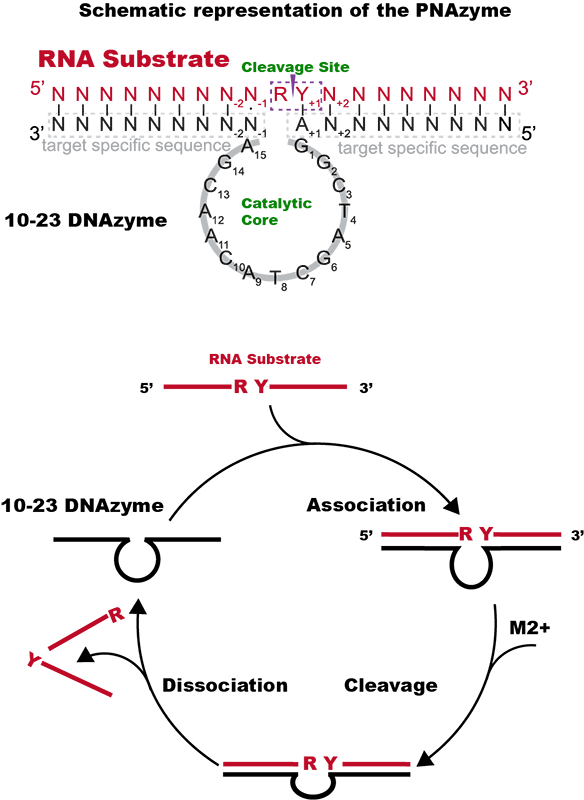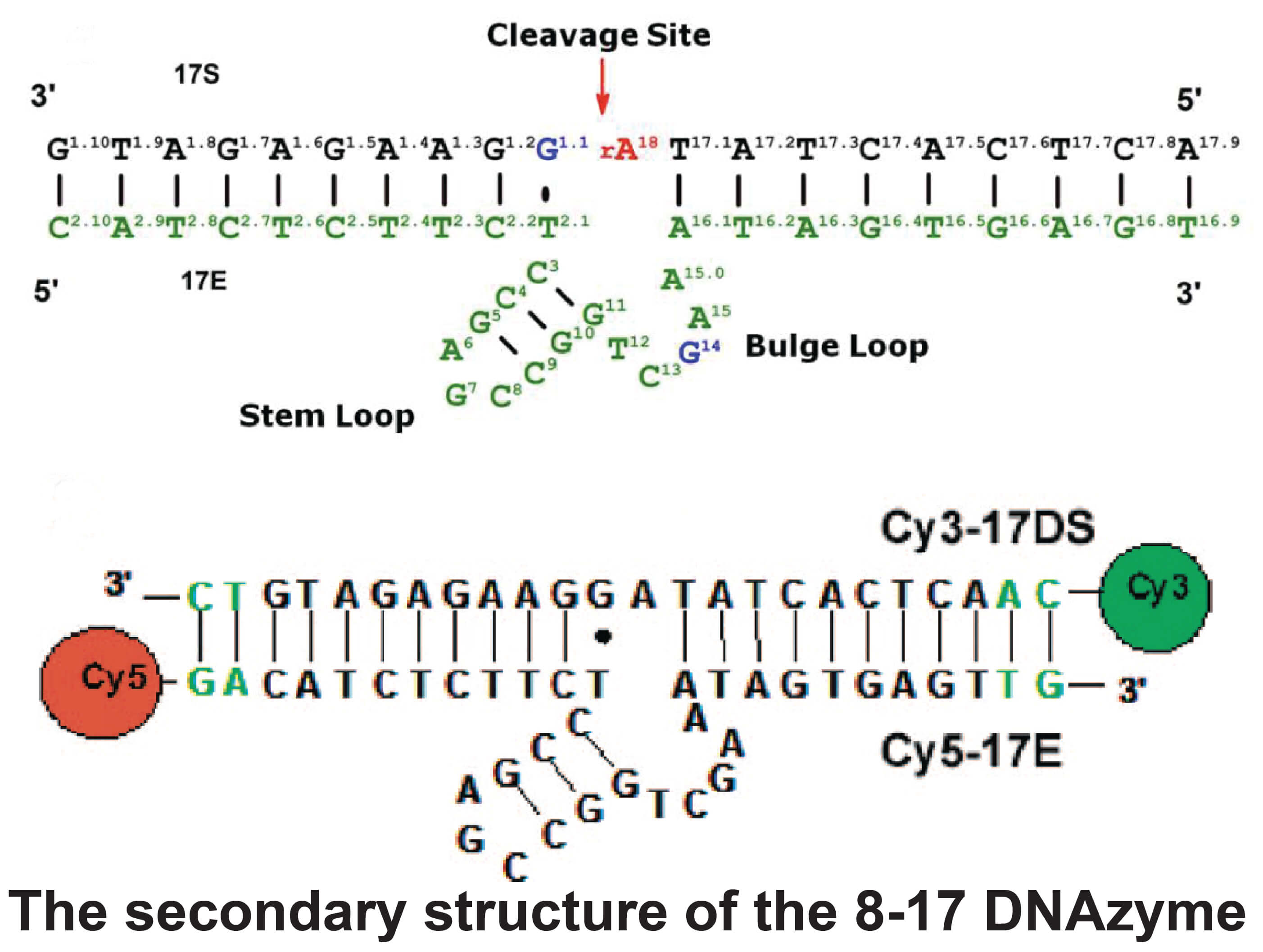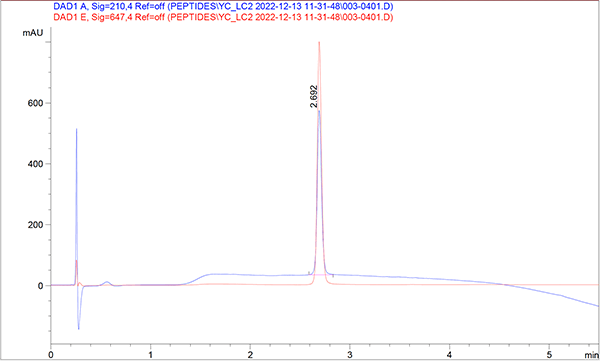Please click here to get a quote for Peptide Nucleic Acids service now!
DNAzymes (also known as catalytic DNA or deoxyribozymes) can catalyze a wide variety of reactions. Due to their stability and cost-effectiveness compared to ribozymes and protein enzymes, DNAzymes have found applications in environmental monitoring, medical diagnostics, and biological imaging.
Researchers have drawn inspiration from the CRISPR/Cas system, where the Cas protein unzips dsDNA, allowing a guide RNA to bind to a complementary DNA strand. A structurally smaller and simpler alternative, Peptide Nucleic Acid (PNA), has shown promise due to its neutral pseudopeptide backbone, which provides increased binding affinity toward dsDNA. This property allows PNA to invade dsDNA, binding to one strand and leaving the complementary strand partially single-stranded, which can then be targeted by another oligonucleotide.
Schematic representation of the 10-23 DNAzyme

Building on this principle, researchers have developed the PNA-assisted double-stranded DNA nicking by DNAzymes (PANDA) system. In this system, PNA “openers” invade dsDNA to expose single-stranded regions, which are then cleaved by ssDNA-specific DNAzymes. The PANDA system has proven efficient in both nicking dsDNA and causing DNA double-strand breaks (DSBs), allowing the resulting fragments to be ligated with other fragments for DNA recombination.
Notably, the PANDA system has demonstrated less off-target activity compared to CRISPR/Cas9 nickase (CRISPR/Cas9n), suggesting it could be a more precise tool for genetic engineering. This advancement holds significant potential for expanding the applications of DNAzymes in molecular biology and biotechnology. The 8-17 DNAzyme and the 10-23 DNAzyme are both catalytic DNA molecules that cleave RNA substrates, but they differ in their sequence, structure, and some aspects of their functionality.
8-17 DNAzyme Structure and Sequence
The 8-17 DNAzyme is composed of a conserved catalytic core sequence flanked by variable substrate-binding arms that can be tailored to hybridize with specific RNA targets.
Schematic representation of the 8-17 DNAzyme

10-23 DNAzyme Functionality
The primary function of the 10-23 DNAzyme is to catalyze the cleavage of RNA at specific phosphodiester bonds. Upon binding to its RNA substrate through the complementary arms, the DNAzyme induces cleavage at a defined site within the RNA, leading to precise and efficient RNA degradation. This catalytic activity makes the 10-23 DNAzyme an invaluable tool in molecular biology for studying gene function and regulating gene expression. The 8-17 DNAzyme is highly efficient in cleaving RNA substrates at purine-pyrimidine junctions, where the cleavage occurs preferentially at G-U or A-U pairs.The 10-23 DNAzyme can cleave RNA substrates at almost any purine-pyrimidine junction, making it more versatile in terms of target sequence.
Applications
Due to its efficiency and specificity, the 8-17 DNAzyme is often used in applications where precise RNA cleavage is needed, such as in studying gene function and regulation. It is also utilized in biosensors and diagnostic tools. The versatility of the 10-23 DNAzyme extends across various applications in molecular biology and biotechnology. The 10-23 DNAzyme’s broader substrate specificity makes it suitable for various applications, including gene silencing, therapeutic interventions, and biotechnological research. Its versatility allows it to target a wide range of RNA sequences, making it a valuable tool in molecular biology.
• Gene Silencing: Used to selectively degrade mRNA transcripts, enabling the study of gene function by observing the effects of reduced gene expression.
• Therapeutics: Potential use in treating diseases by targeting and cleaving disease-related RNA molecules, offering a novel approach to gene therapy.
• Biotechnological Research: Applied in the development of biosensors and other diagnostic tools that require specific RNA cleavage.
Importance in Molecular Biology
The 8-17 DNAzyme and 10-23 DNAzyme are a critical component in the toolkit of molecular biologists due to their specificity, efficiency, and versatility. It provides a powerful method for controlling and manipulating RNA molecules, facilitating advancements in gene therapy, functional genomics, and biotechnology.
Expanding DNAzyme Activity: PANDA
Incorporating the innovative approach of Peptide Nucleic Acid (PNA)-assisted double-stranded DNA nicking by DNAzymes (PANDA), the activity of DNAzymes can be expanded toward double-stranded DNA (dsDNA). PNA, a synthetic polymer similar to DNA, binds to complementary DNA sequences with high specificity and stability. When combined with 10-23 DNAzyme and 8-17 DNAzyme, PNA can facilitate the targeting and nicking of dsDNA, thus broadening the scope of DNAzyme applications to include precise genome editing and manipulation.
LifeTein Peptide Nucleic Acid (PNA) Services
LifeTein's PNA services offer cutting-edge solutions for enhancing DNAzyme functionality and expanding their applications in molecular biology. By leveraging the unique properties of PNA, we provide customized PNA synthesis and design services to meet your specific research needs. Our expertise in PNA technology ensures that you receive high-quality, reliable tools for advancing your scientific discoveries.
Harness the power of the 10-23 DNAzyme, 8-17 DNAzyme and PNA technology to revolutionize your research and achieve new milestones in molecular biology. Contact us today to learn more about our PNA services and how we can support your innovative projects.
PNA oligomers can be labeled at 5' and/or 3' end. These labels are available upon request: fluorophores including FAM, FITC, Alexa Fluor dyes, Atto dyes, Cyanine dyes (cy3, cy5, cy7), QSY9, Pyrene, Dylight, quenchers (BHQ, Dabcyl), Acridine, Butyric acid, Alkyne (DBCO or Pentynoic acid), Azide, Biotin, Maleimide, Myristol, Palmitic acid, et al. Contact us if your modification is not on the list.
Featured PNA Products
| PMP01-25 | Peptide nucleotide acid (PNA) PMP01-25: {GGCAAGTCTTCTTCGGA}-NH2 | |
| APP01-25 | Peptide nucleotide acid (PNA) APP01-25: {GGCTCAACTCTGGACAG}-NH2 | |
| EcoPNA1169 | Peptide nucleotide acid (PNA) EcoPNA1169: Biotin - {CAACACACAGTGTC} | |
| LT8195 | (KFF)3K-PNA:KFFKFFKFFK-CTCATACTCT | $1200, 125nmol, In Stock |
PNA FISH Probes
| TelC telomere probe | CCCTAACCCTAACCCTAA; Reverse Complementary Sequence (5' to 3'): TTAGGGTTAGGGTTAGGG |
| TelG telomere probe | TTAGGGTTAGGGTTAGGG; Reverse Complementary Sequence (5' to 3'): CCCTAACCCTAACCCTAA |
| Pan-centromere CENPB probe | ATTCGTTGGAAACGGGA; Reverse Complementary Sequence (5' to 3'): TCCCGTTTCCAACGAAT |
| Human only pan-centromere CENT probe | AAACTAGACAGAAGCATT; Reverse Complementary Sequence (5' to 3'): AATGCTTCTGTCTAGTTT |
PNA Case Study
This case study shows a complicated PNA synthesis with a fluorescent Cyanine Dye Cy5 modification at the N terminus, and an azido group at the C terminus for the click chemistry for the downstream reactions.
The sequence of the peptide used is as follows:
Cys(Cy5)-{XXXXXX}-Lys(N3)-NH2, X stands for A, T, G, C monomers, Cyanine Dye Cy5, Fmoc-Lys(N3)-OH (Fmoc-L-azidolysine)) was used for the synthesis. The side-chain azido group is completely stable and can be further selectively modified using Staudinger ligation or Click-chemistry.
